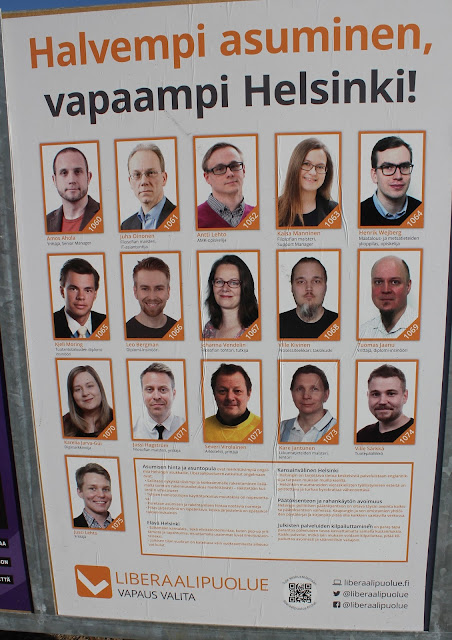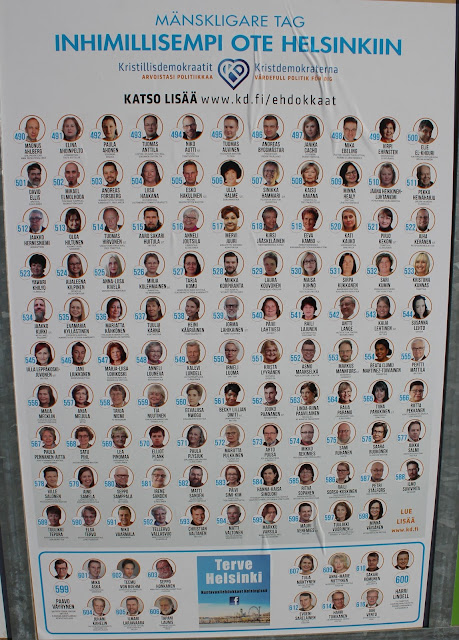I
can’t say I have a head for learning languages. Not by a long shot. That’s unfortunate,
since I ended up in a situation where being a fully functioning member of
society requires speaking a tongue that is not my own. And to my great shame I still
haven’t got the hang of it.
To make matters worse in some sense, I’m surrounded by people who fluently speak at
least two languages, sometimes three or even more. It's not at all unusual here. Finland is clearly a polyglot place, very much unlike where I was born.
As
a kid growing up in the mountains of rural North Georgia, I probably
encountered very few foreign words -- except perhaps, when I think about it,
the word ”parfait”. That was the name of an ice-cream treat at the local Dairy
Queen. Whether it was actually perfect,
I can’t recall. Probably not bad.
In
those days, I might have also occasionally run across some non-English words on
T.V., though the only example I can be sure of was “Jawohl!” barked out now and
then on “Hogan’s Heroes” the 60s situation comedy set in a German prisoner of
war camp during World War II. And I'm sure I sometimes watched Lucille Ball being on the receiving of some choice words from Desi Arnaz in Spanish.
However, my
first real exposure to languages other than English probably came in my
maternal grandmother’s house, where I spent a decent amount of time as a kid.
Grandma Davis had been a school teacher, and most likely had more books than most
folks of her generation in my rural county.
One
of those books -- in fact, the only one I really remember -- was a specialized
dictionary, the Britannica World Language Dictionary, which provided
translations of English words in six languages.
The
book’s format was simple. On the left side of the page was a column of English
words, listed alphabetically. Running from the right of each English word was
its equivalent in French, German, Italian, Spanish, Swedish, and Yiddish. At
the time, I was puzzled by Yiddish. I’d never heard of such a language, though
I could see it appeared somewhat similar to German.
I remember
being fascinated by the dictionary, seeing how you could say something in other
languages. I recall in particular encountering the German words weiss and wein and thinking it was cool that by combining them you get “white
wine”. As a child, I probably didn’t have any inappropriate thirst for weisswein. Maybe it was just the
alliteration that appealed to me.
Maybe
because of this early brush with the language, I always somehow felt a desire
to learn German. For a long time, it was an unfulfilled desire. I suspect not many
American high schools offer classes in German even now, but certainly not in
the 70s in the rural Appalachian Mountains.
In
any case, the only foreign language taught at my high school was French, which
was a recommended subject for students planning to go on to college.
It
was an exotic notion to study French, and I was excited to start the class. Even
today I can recite (more or less) the first bit of dialogue of Français that we
learned.
«Papa, mangeons dans un restaurant ce soir.» «Oui, Papa.
Dinons en ville.» «Excellente idée, mais demandez à Maman d'abord.» «Ah, non. Ne
parlez pas du restaurants ce soir.» «Pourquoi pas, Maman.» «Le dîner est sur la
table.»
“Papa, let’s eat in a restaurant tonight.” “Yes, Papa, let’s eat in
town.” “Excellent idea, but ask Mama first.” “Ah, don’t talk about restaurants
tonight.” “Why not, Mama?” “Dinner is on the table.”
Unfortunately,
after a while, despite a really fine French teacher, my attention span fizzed
and my enthusiasm waned. I believe I studied a full three quarters, but ended
up not doing so well with the French I took.
I’ve
put my high-school French to use only rarely and to doubtful effect. The first
time was probably in 1983 when my future wife and checked into a mostly empty campground near the coast of Normandy. Unsure where we could pitch our tent, I inquired
of the campground’s matron with a “Où?” She understood well enough to answer -- with a Gallic shrug – by pointing around in different directions. I didn't improve much on that over the years. When
we hiked in the Alps a few years ago, my French was no use at all and we had to
depend on one of our sons to parle
with fellow trekkers.
Anyway,
that was French. When I went to the University of Georgia, I finally got my
chance to study German. As with French, the first bit of German text we learned
persisted in my memory:
„Hallo und guten Tag! Mein Name ist Bill Becker, und ich
bin ein Amerikaner aus Chicago. Aber ich bin jetzt in Deutschland. Wo in
Deutschland? In Marburg. Ich studiere hier. Was studiere ich? Deutsche: die
Sprache und die Kultur.“
“Hello
and good day. My name is Bill Becker, and I am an American from Chicago. But now
I am in Germany. Where in Germany? In Marburg. I study here. What do I study?
German: the language and the culture.”
I
used to amuse my kids by reciting that. At least, I thought they were amused.
In
the end, I took four quarters of German at UGA (compare this to my wife, who
took the pitkä kurssi in German, that is, seven years). One of my teachers was an American with an appearance and vibe creepily
similar to the Gestapo agent Toht from “Raiders of the Lost Ark.” You got the
sense that he was drawn to the German language for the wrong reasons.
Another
teacher, my favorite, was an East German with an iconic Teutonic name -- which
I won’t reveal, since after googling him, I see he’s still teaching in the
States. Let’s call him Otto. He was tall, with blond hair and sharp, angular
features you find in the villainous German characters typecasted in almost
every American war movie.
Since
this was 1978, a decade before the Berlin Wall fell and his countrymen could
easily travel abroad, I got the impression that Otto came from some privileged, highly placed
East German family. He had a slightly imperious air about him. He would sometimes lecture us on the faults of capitalist,
and once brought to class a handful of empty food packaging from
McDonald’s -- visual aids to berate us with over the wastefulness of the American throw-away society
(which, natürlich, was true).
Otto
also had a second job teaching at a private school near Atlanta, some 80 miles (130
km) away, and he often complained of getting speeding tickets as he tried to
shuttle between the two schools, apparently at Autobahn speeds.
He once
taught us how to say, “Step on it, Goddammit” in Norwegian, which seemed slightly
sinister to me. He was a character.
I’ve gotten a bit more mileage out of my German. In the past, I sometimes used it as a “secret language” with my wife if we wanted to keep the kids in the dark about what we were discussing. Otherwise, I’ve hardly ever used it with actual Germans, even though I once worked for a half-German company and made regular business trips to München.
At
the Baltic port of Travemünde back in the early 80s, as my wife and I waited to get a flat tire repaired at
a service station, a man said something to me which I naturally didn’t understand. In response, I said “Ich spreche kein Deutsch.” (“I speak no German.“)
He corrected me: “Nein, du sprichst schlecht Deutsch.” (“No, you speak bad
German.”) Genau!
So,
that was German. When I briefly went back to university to study journalism in
the late 80s, I decided to take another stab at language learning, apparently
just for the hell of it. In this case, it was Spanish. And it was for one
quarter only, so no hablo mucho Español.
Obviously.
Even
from that single course in Spanish, I came away with one little language artifact. My
teacher was a Spaniard, as in from Spain across the ocean -- and this in a
hemisphere of almost 420 million native Spanish speakers. Because of her, I learned the
Old World Spanish pronunciation of the letter “c” (before “i” or “e”), that is,
the Castilian pronouncement. For this reason, I think of Barcelona as “Barthelona”.
I’m
bizarrely proud of this, though that doesn't speak well for my solidarity with my fellow
New Worlders in Latin America. As it is, we don’t talk with each other that
much anyway.
I’d
like to think that if I had remained living in the States, I would have actually
learned Spanish. It is, after all, America’s de facto second language.
And
then there’s Finnish, which I’ve been struggling to learn for, well, for
decades, despite dozens of books and courses and living fulltime in the country
where people speak it constantly. I have no excuse other than, as I said, I
don’t have a head for languages.
That’s
five languages I’ve studied, and still haven’t come close to mastering any of
them, except for English – and I may be regressing with that one.
But I'm not stopping, it seems. I’ve now gotten hooked on the online language-learning apt, Duolingo.
I can't be sure how effective Duolingo really is as a learning tool. But its
game-like format (with positive reinforcement through "rewards” and triumphant sound effects, and your progress marked by reaching different "levels" and other metrics) makes it a “fun” approach to language study. If nothing else, it’s a decent way to spend time, educational, you might
say. And, similar to crowd-sourced sites like Wikipedia, it’s available for free.
It currently
offers English-speakers the chance to learn some 20 languages, mostly European,
but also Vietnamese and Swahili. Other courses are under development
(“hatching” in Duolingo parlance), including Japanese, Hindi, and...Klingon!
Unfortunately, not Finnish. Not yet. Obviously, that’s harder to implement than
Klingon.
I
started doing occasional Duolingo lessons in German and French three or four
years ago, just to brush up on those two. When the long-awaited Russian course was added in late 2015, I begun
that one, too. And just recently I started studying the language of another neighboring
country, namely Swedish.
It’s
true that “studying” these four languages simultaneously may not be wise, especially when I've got much more Finnish still to learn. But that’s
the way I do it, generally one lesson of each language every day. The
lessons are short, so it usually takes about half-an-hour to do all four. In other
words, it doesn’t eat up much of my day.
Am
I learning anything? Well, according to Duolingo’s algorithm, I am now 42%
fluent in French – my wife often chokes on her café au lait when I boast about this fact.
In
German, my fluency is 33% and in Swedish it’s already 27%, although I started it only six months ago. It’s such a damn easy language. So far, Duolingo hasn’t
given me a fluency score for Russian (which is NOT an easy language), but that
course still seems to be very much a work in progress. It wouldn’t be an
impressive score anyway. It’s fair to say I am struggling with Russian.
But considering my track record with languages, that should come as no surprise.
But considering my track record with languages, that should come as no surprise.














